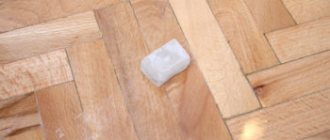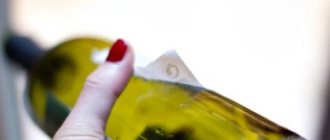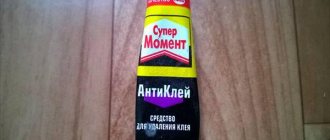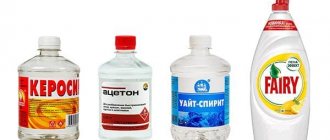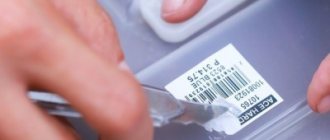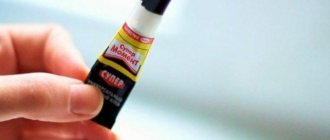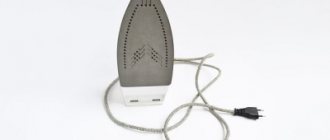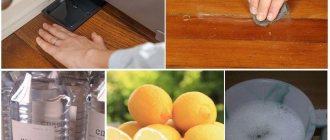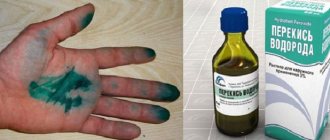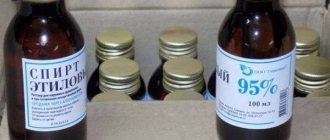How to remove primer stains from linoleum?
A product that does not contain soda or alkali is suitable for cleaning. Solvents "White spirit" and "646" are the best option. In order to get rid of the remnants of the dried suspension, you should apply the cleaning agent to a cotton pad and wipe the surface. Repeat the procedure until completely cleansed.
Interesting materials:
How to use the iron's self-cleaning system? How to change the background on a photo? How to change a photo in Photoshop? How to change the game language in Epic Games? How to change the keyboard language on Honor? How to change the language on the keyboard of a Huawei tablet? How to change the interior of a room without renovation? How to change the keyboard on Xiaomi Redmi 4x? How to change the number of cores? How to change the tape in the payment terminal?
What to do immediately after glue gets on the laminate
If you were able to immediately notice the spilled glue, that’s good. The preparation has not yet had time to harden, and you can simply blot it with a paper napkin. And after cleaning, you should wipe the stained area with a damp cloth so that no traces of glue remain.
Another way is to quickly prepare a soap solution (1-2 tablespoons of liquid soap or dish gel per 1 liter of warm water) and wash off the dirt using a sponge. The water must be wiped up immediately so as not to spoil the floor.
And when the substance has time to set and is no longer “taken” with a napkin, you can try to clean it off with something thin (not metal):
- plastic spatula;
- toothpick;
- cosmetic scraper (like gouache);
- disposable knife.
Methods for cleaning laminate flooring from glue
Once the glue has hardened, it will no longer be possible to remove it with either paper or a plastic knife. More “serious” methods are needed.
Mechanical removal
It’s definitely not worth rubbing laminate flooring with a kitchen brush, brush, or sandpaper. This will be of little use. Even if you manage to clean off the hardened glue, the decorative layer of the coating will be damaged by scratches, which are always very noticeable.
It is customary to remove only small drops mechanically. There are subtleties here:
- You shouldn’t pick off a drop from the floor - it’s better to sand it carefully;
- Emery is good for sanding (a small piece so as not to touch the clean laminate around a drop of glue);
- there is no point in wiping off the entire stain - the glue is transparent, and the remnants of the rubbed drop on the floor are invisible.
Household chemicals
The following household chemicals can deal with dried stains:
- acetone (very aggressive - it is better to first check the reaction on an inconspicuous area of the laminate);
- window cleaners (based on ammonia, but do not harm the laminate as much as pure ammonia);
- any chemicals containing solvents;
- a special anti-adhesive preparation (more about it below).
Chemicals should be applied carefully, in small doses. It is better to use a cotton pad or small rag for application. You shouldn’t just pour and spray the product on the laminate - there is a risk of damaging the smooth surface.
Alcohol
Glue stains can be safely wiped until completely removed:
- alcohol wipes;
- cotton wool soaked in pure ethyl alcohol;
- vodka.
It is not advisable to use ammonia and formic alcohols - they can damage the laminate. It is worth refraining from cleaning with denatured alcohol. And isopropyl alcohol is simply ineffective.
Soda
A universal remedy for cleaning any stains is a paste of soda and water:
- Mix soda and cold water in approximately equal quantities. It should come out like a paste, but if the mixture turns out to be more liquid, that’s not a problem.
- Spread a continuous layer onto the adhesive stain. Do not rub so as not to scratch the laminate.
- Leave for 2-3 hours.
- Wipe off the baking soda with a dry paper towel. Along with it, a significant part of the glue will be wiped off, and the remains can be easily washed off with clean water.
This method is recommended for old laminate flooring, which can be easily damaged by more aggressive means. Nothing will happen to him from soda.
Table vinegar
9% vinegar can be poured onto the floor without fear - it will corrode the glue, but will not ruin the laminate. And more concentrated solutions (especially pure essence) should be carefully applied with a cotton pad. It will take vinegar at least 30-40 minutes to soften the stain, but then the glue can be easily wiped off with a napkin.
Oil
Oil behaves differently than other products - it does not soften the stain, but penetrates under it. The adhesive remains firm but comes off easily from the laminate. It is permissible to apply and leave the oil on the coating for any time - even overnight. Nothing will happen to the laminate, because it does not absorb fat.
The following oils work well:
- vegetable (sunflower, olive);
- cosmetic;
- petrolatum.
Anticlean
A very powerful tool is a debonder. Russian manufacturers call it anti-glue.
Effective debonders come out under the following brands:
- "Super Moment";
- "Second";
- “Strength” (this brand has a tube of debonder sold along with a tube of superglue).
The product is applied to the dried glue and left until it softens, becoming like a paste. “Melted” glue can be easily removed with a toothpick and a cotton swab. After treatment, the coating area should be wiped with a detergent - for laminate or universal.
Hairdryer
You can also soften the glue by applying temperature. A hairdryer with warm air is brought to the stain and held close (but not pressing) until the stain becomes softer. This will take from 5 to 20 minutes - depending on the age of the contamination and the composition of the glue. Then they just wipe it off.
In addition to the hair dryer, the following are suitable:
- iron (but do not press it to the laminate);
- steam generator.
Nail polish remover
A liquid containing butyl acetate will work well on glue stains. Products without this component are almost useless. Use it like this:
- Soak a small piece of soft cloth with the liquid.
- Rub the dirt with a cloth.
- Leave for 5 minutes.
- Rub again. When removing dried glue, you will have to repeat the steps several times.
- Wash off with soapy water to get rid of the pungent odor.
Hydrogen peroxide
Peroxide releases active oxygen and corrodes dried glue:
- Impregnate a piece of white fabric with the substance (bright dyes can “transfer” to the laminate).
- Rub the stain with peroxide.
- If the contamination is large, cover with the same cloth and leave for 5 minutes.
- Wipe off the softened glue.
- Immediately wash off traces of peroxide from the laminate so as not to damage the smooth surface of the coating.
The procedure can be repeated several times. The main thing is to avoid continuous contact of peroxide with the floor covering for more than 5 minutes.
White Spirit
The only solvent that can come into contact with laminate. Others are too aggressive to the film on the laminate surface. Use white spirit in the same way as peroxide, in the same order. Instead of 5 minutes, you can leave it for 10-15, but no longer.
How to clean the floor until it shines
A mop with a sponge and soft, easy-to-wring-out rags for cleaning the floor will help to clean the laminate flooring thoroughly. The water should be warm, with the addition of a special product for laminate flooring.
To wash the floor covering to a shine, without streaks, proceed as follows: the first time, wash the surface with water and a special product, the second time - with clean water, often rinsing and squeezing the sponge or rag well. Make sure that moisture does not accumulate or remain on the floor.
To ensure a clean floor retains its shine, do not walk on it barefoot - otherwise marks will remain on the surface. Use house shoes with soft soles.
Features of the composition
Universal glue “Moment” has a very complex composition.
Let us highlight the main components contained in the adhesive mixture:
- polychloroprene rubbers;
- dimethyl ketone;
- ethyl acetate;
- phenol-formaldehyde resins;
- aliphatic hydrocarbons;
- special additives that make the mixture inert to chemicals;
- colophon resin.
Thanks to this composition, the material has high technical characteristics. The solution is capable of gluing almost any material. The mixture dries quickly on the surface, forming a strong connecting film.
On the modern building materials market, there are several modifications of Moment adhesive , which differ in certain qualities, composition and scope of application. If we talk about the universal mixture, then it is suitable for repairing any small items. It is the universal glue “Moment” that is most often used in everyday life.
This composition has unique characteristics.
- Versatility of use. The mixture can glue almost any materials.
- Water resistance. The glue can be used to repair items that are exposed to water and moisture during operation.
- The solution can be used after it has been frozen and thawed. The glue will not lose its technical characteristics when exposed to low temperatures.
- It is a flammable material. It is necessary to work with it away from sources of fire. Products treated with this product should not be exposed to high temperatures.
Means for cleaning dirty areas
Operational approach
The generally accepted universal solvent is ordinary water. It allows you to wash any place stained with glue or other water-based adhesive. The list of products susceptible to water includes the following types of glue:
- clerical;
- latex;
- PVA;
- vegetable;
- carpentry
The manufacturing principle for all these subtypes is the same: a mixture of water and an adhesive intended for gluing an object to any type of surface.
If you do not have the time or opportunity to read the entire article, watch the video on this topic:
After the applied bonding liquid has completely dried, the adhesive bonds to objects, including machine surfaces.
Removing the glue is quite easy if the glue has not yet completely dried. To do this, excess glue in the area where something was glued must be collected with a rag.
The area should then be thoroughly rinsed with water until all residue has been removed.
Alcohol: destruction of fastening components
The surfaces of various objects and planes, including various external parts of the machine, can also be tidied up using a solvent such as alcohol, which successfully copes with a wide range of adhesive joints.
The effect of alcohol is expressed by the fact that the components of the glue dissolve to such a state that they stop sticking to surfaces.
If alcohol is applied directly to the area where something has been stuck, you can see impressive results within a few minutes.
If the structure of the glue is one of the alcohol-soluble products, you can see how it begins to soften. You can remove the sticker in the same way.
The final stage in any of the presented situations is to remove residues and rinse the item.
Acetone: manicure product for other purposes
You can also remove glue from clothing or glass areas using acetone. To do this, a cotton swab is soaked in it, which is then placed on the surface with glue.
After some time, armed with a toothbrush, you can completely remove all the residue. The steps must be repeated until the adhesive bonds existing between the glue and the material are dissolved and weakened.
In this way, a variety of types of glue can be removed from clothes and other objects, including such a variety as a product with the prefix “super”.
Exposure to oils
There are often situations when glue that gets on noticeable parts of clothing or other surfaces cannot be affected by water, alcohol, or even acetone.
In this case, it makes sense to turn to a product such as baby or vegetable oil.
Don’t be afraid to stain the item of clothing you are cleaning: the oil will perfectly dissolve even glue residues without harming the item itself.
The effectiveness is due to the fact that many types of glue are characterized by an oil base, which makes it possible to clean certain types of contaminants.
After even the slightest trace of glue has been dissolved, you need to wash the treated area with soap and water.
Destruction with vinegar
You can also remove glue and its traces with vinegar. You will need a liquid whose composition is water and acetic acid. The second component is characterized by the ability to destroy the glue.
Vinegar is applied relatively liberally to the stained area. After twenty minutes, the glue begins to dissolve. Finally, you need to use a cloth to remove the mark.
A similar procedure is carried out when the problem is a trace of stickers on the plastic.
A simple kitchen remedy
Traces of stickers on plastic, as well as traces of adhesive tape, can be easily removed with baking soda. One tablespoon of baking soda and one teaspoon of water are mixed until a thick mass forms.
The mixture is applied to the adhesive area. After a short wait, everything is cleaned with warm water.
This way you can remove not only traces of the sticker from the plastic, but also glue residues on any surface.
Healing ointment removes dirt
Sticker marks on plastic and similar stains can be removed by using a little Vaseline. You need to start with an extremely small amount, gradually adding new portions to it until the desired goal is achieved.
The same approach can be applied if the problem is traces of tape. Finally, the treated area is wiped and washed with warm water and soap.
Hot air
Traces of adhesive tape on the surface of the glass, as well as various types of glue, can be removed by using...a hairdryer. By heating, the adhesive substance softens, after which it can be carefully scraped off with a plastic or metal scraper.
Removing different types of glue
Different glues have their own differences, depending on the active components in the composition. And you have to wash the glue from the laminate with an eye on these differences.
Super glue
Preparations called superglue are always cyanoacrylate based. The component is responsible for ultra-fast curing. Useless against him:
- high temperatures;
- soda;
- table vinegar (but concentrated essence can help).
The best way to clean laminate flooring is with a debonder from the same brand as superglue. Almost all superglue manufacturers also produce anti-glue - finding one in a hardware store will not be a problem.
Moment
According to the principle of action, the adhesive moment is similar to superglue, but does not contain cyanoacrylate. Therefore, heating with a hairdryer is a very good cleaning method. The oil method also works reliably.
Wallpaper glue
Wallpaper adhesives do not stick as strongly. They are easy to wash off:
- plain water;
- soap solution;
- windshield wipers.
The stained laminate can be sprayed with water from a spray bottle and left for 10-15 minutes. Such a small volume of water will not damage the coating, but will soften the wallpaper glue. Then easily wipe the stain with a napkin, cloth, or plain paper.
Regular care
To wash laminate flooring during daily cleaning, warm, clean water and a well-absorbing cloth are sufficient. Wash the floor once with a damp microfiber, wipe a second time with a rag wrung out of moisture. Use special detergents for laminate flooring after 3-4 cleanings with clean water.
Attention:
Laminate flooring must not be washed with products containing acid.
As a rule, laminate flooring is cleaned daily with a vacuum cleaner and wet cleaning is carried out once a week. To combat tarnishing, use water and vinegar.
Deeply ingrained and old stains that cannot be cleaned can be masked with a special restoring paste for laminate flooring. When processing, follow the instructions on the package.
Advice:
Make sure that water does not penetrate into the joints between the panels. This causes them to swell and swell, which will require expensive repairs.
If you are concerned that you will not be able to properly remove stubborn stains without damaging the surface, contact a cleaning company. Cleaners use specialized equipment and products that safely clean the floor and renew its appearance.
